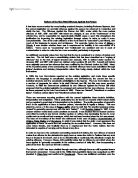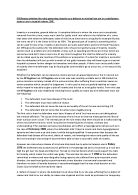Provocation. The provocative act must cause the defendant to suddenly and temporarily lose their self control as shown in R v Duffy. Evidence to show that Eleanor lost her temper is the fact that in a state of agitation, she bought a container of flammabl
Provocation: Exam Question 2002 Provocation is a special defence. This means it is only available to a defendant if they have been charged with Murder, it cannot be used for any other offence, and if it is successful the defendant will be convicted of manslaughter rather than murder. The provocative act can be anything said (R v Newell) or done, and the acts can be directed at or not at the defendant (R v Davies). The relevant case here is R v Davies where the provocative act was not directed at the defendant because the defendant saw his wife (victim) with her "friend" outside the library, merely seeing this was enough provocation for the defendant to shoot his wife. Similarly, Eleanor was convinced that Fiona and Gordon were making a lot of noise in order to disturb her, even though Fiona and Gordon were unaware that Eleanor was angry with them. This was therefore an indirect act but provocative enough for Eleanor to carry out the unlawful act. The provocative act must cause the defendant to suddenly and temporarily lose their self control as shown in R v Duffy. Evidence to show that Eleanor lost her temper is the fact that in a state of agitation, she bought a container of flammable liquid. If an apparently small incident causes the defendant to kill then the jury may doubt whether there had been a loss of control because the provocative act was so trivial such
Describe the power of the police to stop and search a person on the street
Sheena Shah Law exam question: Describe the power of the police to stop and search a person on the street The law containing police powers is defined in the Police and Criminal Evidence Act (PACE) 1984. It’s mainly stored in sections 1-7 of PACE, which contain police powers to stop and search people and vehicles. Section 1, consists of the right to stop and search in a public place like a car park, street or private garden which is not owned by the suspect being stopped, it is only then lawful. This section also covers that police officers can stop and search when he/she has reasonable grounds for suspecting that the person is in possession of stolen goods and prohibited articles such as, weapons, drugs or items used for burglary. After which then the officer is allowed to seize such items from any persons. Section 2 of PACE indicated that if in public, the suspect can only be asked to remove their outer jacket, coat and gloves. If then it is decided more is in need to be removed he can ask if the suspects t-shirt and shoes be taken off but under private conditions out of the eye of the public. A place such as the station or the back of a police van is used to do so. Officers also have to give their name, station and reason for search accompanied with a written report, either on the spot or at the station during the search otherwise it may be seen as unlawful. Most
Notes on the law on murder
Murder There are three types of unlawful homicide: murder, voluntary and involuntary manslaughter. The degree of seriousness applied to each offence is essentially a reflection of the defendant’s state of mind. With regard to the killing – murder is the most serious category of unlawful homicide. Definition: “Murder is the unlawful killing of a human being under Queen’s peace with malice aforethought”. Actus Reus of Murder (Pagett, Jordan, Smith and Blaue) The actus reus of murder simply consists of the unlawful killing of a human being under Queen’s peace. It can be broken down into three main elements: The unlawful killing – the killing must be unlawful. The victim must be a human being – normally, this will be self evident but it is murder to kill a foetus (unborn baby) because it is fully independent of its mother. Queen’s peace – any killing within England and Wales by any person. When discussing actus reus of murder, it is vital to discuss causation along with the think skull rule, and apply it back to the case. Causation is establishing a direct link between the defendant’s conduct and the consequences. The prosecution must prove that defendant’s act was both legal and factual cause of death. Factual – use the “But for” test. But for the defendants conduct, would the consequences have occurred? R v Pagett – Pagett’s
Status of Terms in Warranties and Contracts
STATUS OF TERMS There are many different status of terms: warranties conditions and innominate term. The law seeks to classify legal terms according to their importance, with implication that a breah for the innocent party varying according to the type of term breached for these purposes. A condition is an essential term. It goes to the root of the contract, and is fundamental. A breach such term entitles the innocent party to repudiate the contract, so need not render any further performance, as well as claim for damages. In the case of Bunge Corp v Tradax Export, the seller contracted to sell to ship 5000 soya bean meal to the buyers. They were supposed to be given 15 consecutive days of notice, but was only given 13. The buyers obligations to give a notice was held to be a condition because it would be unfair to depricv the seller of the notice. There are certain types of terms that the law classify as conditions. For example the Sale of Good Act describe certain terms as conditions and it should never be breached. For example, goods must always match the description, always be of staidfactory quality, good bought in bulk must fit the sample. It should follow that in the event of a breach, a buyer should be able to rescind the contract. This protects the buyers from malicious sellers that have an unfair bargaining position over them In the case of Mihalis Angelos, the
Explain the meaning of the term "causation"
Explain the meaning of the term “causation” Sometimes the defendant’s actions have to result in a particular consequence. These are known as result crimes; an example would be assault occasioning actual bodily harm, where the conduct is assault and the result ABH. The rules of causation decide whether the defendants act caused the prohibited consequence. The court must establish both causation in fact, and causation in law. To determine factual causation, the “but for” test is used. This says that but for the defendants conduct, would the victim have suffered the harm. An example of the but for test would be in R v White, where the defendant put cyanide into his mothers drink, however she died of heart failure before the cyanide could affect her. The but for test showed she would have died regardless of him putting cyanide into her drink, so there was no factual causation. Once factual causation has been established, the court must then establish legal causation. This asks whether the defendant made a significant contribution to the injury. In R v Blaue a Jehovah ’s Witness was stabbed and refused a blood transfusion, that would have saved her life. She later died, and the defendant was found guilty as he made a significant contribution to her death. If a victim acts in a foreseeable way such as in R v Roberts, where a woman was being sexually abused and






















